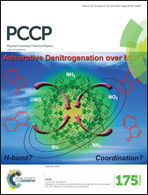Low electron-polar optical phonon scattering as a fundamental aspect of carrier mobility in methylammonium lead halide CH3NH3PbI3 perovskites†
Abstract
High carrier mobility is often invoked to justify the exceptionally long diffusion length in CH3NH3PbI3 perovskites. Using a combination of an ab initio band structure and scattering models, we present clear evidence that large electrical and Hall mobilities are crucially related to the low scattering rate of carriers with polar optical phonons, which represents the dominant mobility-limiting mechanism at room temperature. With a charge-injection regime at room temperature, we obtained carrier relaxation times (τrel) of ∼10 fs, which are typical of polar inorganic semiconductors, and electrical mobilities (μ) as high as ∼60 cm2 V−1 s−1 and 40 cm2 V−1 s−1 for electrons and holes, respectively, which were robustly independent on the injected carrier density in the range of n ∼ 1014 cm−3 to 1020 cm−3. In the absence of a significant concentration of trapping centers, these mobilities foster diffusion lengths of ∼10 μm for the low injection density regime (n ∼ 1015 cm−3), which are in agreement with recent measurements for highly pure single-crystal perovskites.


 Please wait while we load your content...
Please wait while we load your content...